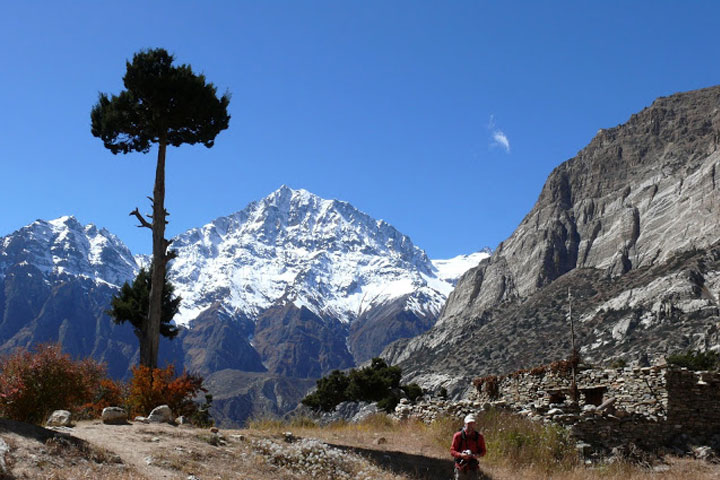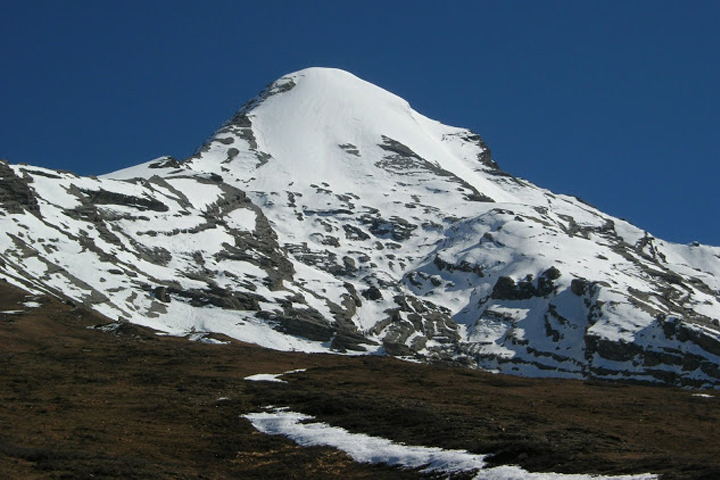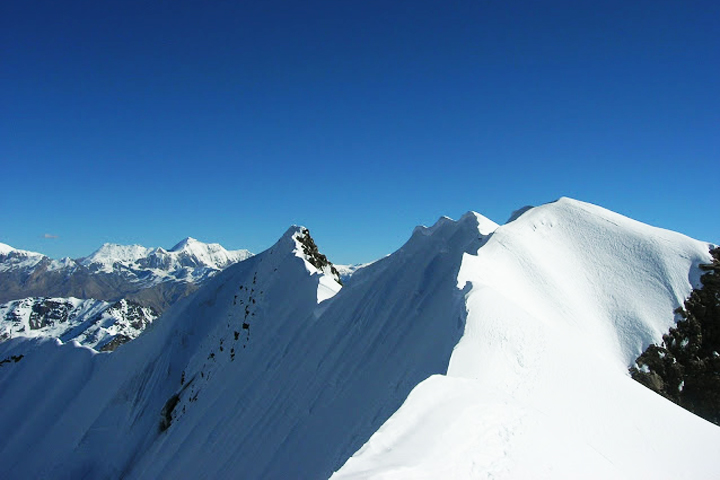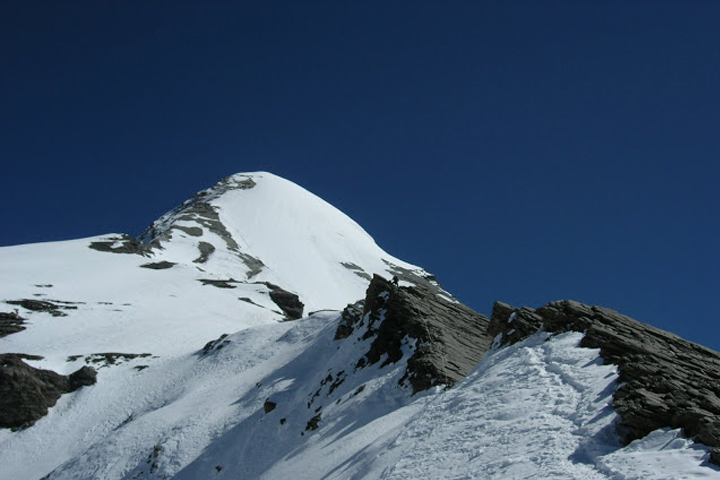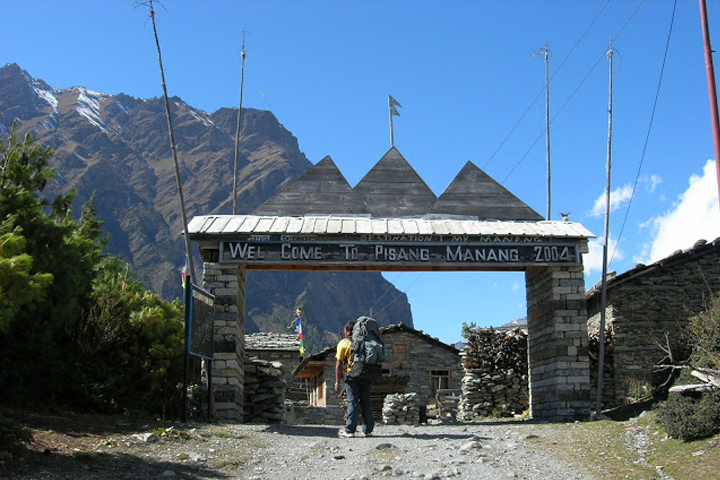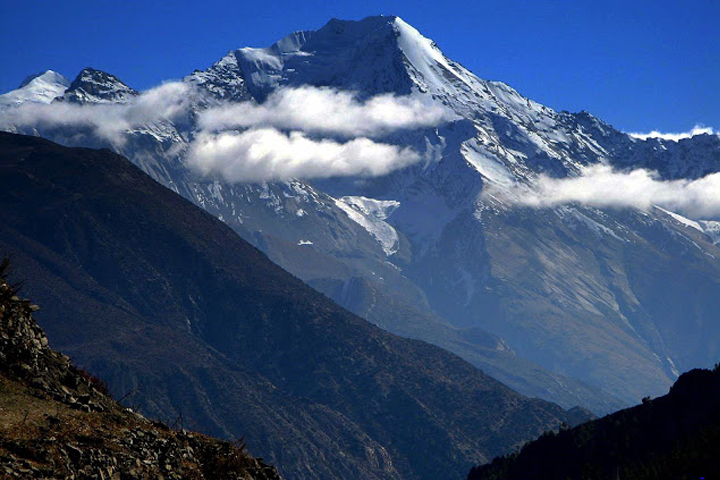Pisang Peak stands at elevation of 6091 meters up above from Pisang village in Annapurna Himalaya range and yak pastures in a uniform slope of ice and snow to the final summit pyramid. Pisang peak is considered one of the busy climbing peaks among the trekking peaks in Nepal. To reach the base camp from Pisang village, the path ascends through sparse wood and pasture to a Kharka at 4420meters, which is considered the best place for setting up the base camp. High Camp is set up at 5450meters, climbing to a shoulder on the South-West Ridge. There will be snow at the high camp from the end of November to the end of March. The well-defined ridge leads to the final snow slop, which is quite steep but not difficult to reach the summit. Descent is made on the same route.
After the your main adventure of Pisang Peak the trek leads to Thorung La pass (5416 meters), through Manang, Ledar, which are the main attraction of whole Annapurna Circuit trek. Due to the difficulties of crossing the pass, the circuit is usually walked in a counter clockwise direction.
After you cross the Thorung La pass the trail take you to the Muktinath then Jomsom from where we can take flights to Pokhara.
Day 01- Arrival in Kathmandu airport (1345meters).
There you will be met by our Airport Representative and transferred to hotel by private tourist vehicle. Overnight at hotel.
Day 02- Kathmandu city tour.
Your sightseeing trip will start at 9 AM in the morning after your breakfast. We will provide a private vehicle and professional tour guide. Places we visit Pasupatinath temple, Buddhanath, Monkey temple, Bhaktpur durbar square and Kathmandu durbar square. The afternoon includes a final briefing and preparations for the trek. Overnight at hotel.
Day 03- Drive to Besisahar (830meters) by bus. 7 hours.
Trekking staff will arrive at your Hotel at 7.00 am in the morning to pick you up then 7 hours driving journey to Besishar. It is about 185km driving. Overnight at guesthouse.
Day 04- Trek to Bahundanda (1310 meters) 5 hours.
Today our journey starts at Besisahar, from where, the trail makes a slight climb to Khudi, we then reach the first Gurung village at Bhulbhule. Our first day introduces us to the cultural elements of Nepal; we encounter a typical local house and the different faces of the various people, exchanging greetings Namaste as we pass. Overnight at guesthouse.
Day 05- Trek to Chamje (1400meters). 5 hours.
Today the trail drops steeply to Syange at 1070meters from Bahundanda crossing the Marsyangdi River on a suspension bridge. We then follow the river to the stone village of Jagat before climbing through forest to Chyamje at 1400meters. Overnight at guesthouse.
Day 06- Trek to Bagarchhap (2160meters). 5 hours.
Our day begins with the rocky trail following the Marsyandi Rivers steadily uphill to Tal at 1675meters, the first village in the Manang district. We make a trail verse crossing a wide, flat valley. The trail then climbs a stone stairway to 1860 meters till another stairway. The journey continues up and down to Dharapani at 1890 meters. There we find a stone entrance chorten typical of the Tibetan influenced villages from here northwards. We then reach the Bagarchhap at 2160 meters that offers the typical flat roofed stone houses of local Tibetans design although the village which is still in the transition Zone before the dry highlands. Overnight at guesthouse.
Day 07- Trek to Chame (2630meters). 5 hours.
The trail climbs to Tyanja at 2360 meters, then continuing through forest, but near the river, to Kopar at 2590meters. As we reach the Chame, the headquarters of the Manang district, we are rewarded by the fine views of Annapurna II as you approach Chame & two small hot springs by the town. Along this route we are introduced to a local community said to have migrated from Tibet a long time past, noticeable by their different features. With them, they have bought local Tibetan house designs and maintained their ways. Overnight at guesthouse.
Day 08- Trek to Pisang (3300 meters) 5 hours.
The day starts through deep forest in a steep and narrow valley, crosses a river on a long bridge at 2910meters. We then cross another bridge at 3040meters, from there the view of the soaring Paungda Danda rock face really begins to appear. From there the trail joins to climb to Pisang, which sprawls between 3200m & 3300meters. Overnight at guesthouse.
Day 09- Acclimatization and explore around.
Today we spend a day acclimatizing in Pisang. The whole day we spend doing some fine day walks and over viewing the magnificent views around the village & the day time is best to gain altitude. At the end of the day, we return back to our accommodation & have a night rest. Overnight at guesthouse.
Day 10- Trek to Pisang Peak Base Camp (4420meters) 6 hours.
The trail is steep ascent passing through Upper Pisang. En route you cross forests of pine and local vegetation. The views of Annapurna rang welcome you. From today the accommodation will be tented camp for few days and you will be having camp food cooked by our professional cook. Overnight at tented camp.
Day 11- Base Camp to high camp (5450meters) 6 hours.
Today the trek leads along rocky glacier path to High Camp. You will be completely charmed by the panoramic views of Annapurna range, Chulu East, Chulu Far East, Nawal peak, Tilicho peak and many other unnamed mountains and peaks. Overnight at tented camp.
Day 12- Acclimatization and explore around high camp.
We will spend a day here in order to acclimatize and adjust to the thinning of the air. As well as a short trek around camp to pre-pare us for the 6000 meter adventure the next morning. Overnight at tented camp.
Day 13- Summit day (6091meters) and return to Base Camp.
Today is our main adventure day, we start early in the morning to climb Pisang peak but it all depends on the weather condition. At the summit of Pisang peak, you can have closer panoramic views of Annapurna range, Chulu East, Chulu Far East, Nawal peak, Tilicho peak, Manaslu, Ganesh Himal, Tibetan mountains, Kang Guru Peak, Gyaji Kang peak, Tilje peak, Kuchubhro peak and many more. After a safe trip to the top we safely make our way down to base camp. Overnight at tented camp.
Day 14- Spare day in case of bad weather.
Day 15- Trek to PisangVillage (3300 meters) 5 hours.
The trail moves steep down all the way to Pisang village. The view of Annapurna range accompanies you. From today the accommodation will be again guesthouse for the rest of the trip. Overnight at guesthouse.
Day 16- Trek to Manang (3500meters) 6 hours
Today we continue through the drier upper part of the Manang district, cut off from the full effect of the monsoon by the Annapurna Range. People of this region herd the yaks & raise crops for part of the year. They also continue to enjoy special trading rights gained way back in 1784.Leaving Pisang, we have alternate trails north and south of the Marsyangdi River which meets up again at Mungji. The southern route by Hongde, with its airstrip, at 3325meters which involves less climbing than the northern route via Ghyaru, though there are better views on the trail that follows the northern bank of the river. From Mungji, the trail continues past the picturesque but partially hidden village of Bryanga at 3475meters to nearby Manang at 3540meters. Overnight at guesthouse.
Day 17- Trek to Yak Kharka (4000meters) 5 hours.
Today we leave Manang, & the trail makes an ascent of nearly 2000meters to the Thorung La pass. We make the climb steadily through Tenki Manang, leaving the Marsyangi Valley. Continuing along the Jarsang Khola Valley, we reach Yak Kharka at 4000 meters, there we see the many yaks and vegetations steadily more sparse. Overnight at guesthouse.
Day 18- Trek to Thorong Phedi (4450meters) 5 hours.
Today, the trail descends to cross the river at 4310meters we then climb up to Thorong Phedi at 4450meters where we have recently found some good Guesthouses built. Our overnight stay will be there. Overnight at guesthouse.
Day 19- Cross Throng la pass (5416meters) and trek down to Muktinath (3800meters). 7 hours.
Today is a long trek starting before sunrise at 4 am to reach the pass by 9-10 am otherwise weather conditions will greatly affect the journey. We cross over at an altitude of 5416 meters we can be exposed to strong winds if crossing too late. We start to climb steeply that is regularly used and easy to follow. However, the problem may arise due to the altitude and snow. It often causes terrible problems to cross the pass if it is covered by snow. About four hours climb up to the pass marked by the chortens & prayer flags. As you reach the top, you are rewarded by the magnificent view from the top with another 4 hours trek will take to the holy town of Muktinath.
Muktinath means place of Nirvana and is home to the Muktinath temple as well as several monasteries. It is said that all sorrows you feel are relieved when visiting the Temple, which is a scared pilgrimage site to both Hindus and Buddhists. The main pilgrimage normally takes place in September. The Temple is dedicated to Lord Vishnu and has 108 waterspouts around it from which Holy water pours. Another attraction nearby is the Jwala Mai Temple this contains a spring and an eternal flame fed by natural underground gas. Overnight at guesthouse.
Day 20- Trek to Jomsom (2715meters) 5 hours.
Our descent continues through the Kali Gandaki Valley to Jomsom, which is also headquarter for whole Mustang district and is home to many apple orchids as well as all the various food products made from the fruit. Apple Brandy is a local specialty that you may be lucky enough to taste en route. Overnight at guesthouse.
Day 21- Morning flight to Pokhara
Today 30 minutes morning flight takes us to Pokhara from Jomsom. Once we arrived at Pokhara airport, we then drive to hotel. In the afternoon we will have a sightseeing tour around Pokhara valley, which covers Fewa Lake, Devi’s water fall, Museum, Tibetan refugee settlement and Gupteshower cave etc. Overnight at hotel.
Day 22- Drive to Kathmandu by tourist bus. 7 hours.
Overnight back at the hotel in Kathmandu by bus. If you are interested in continuing onto Chitwan Jungle Safari, River Rafting Adventure, Kathmandu Shopping Tour or Scenic Everest Flight. Overnight at hotel.
Day 23- Transfer to international airport for your final departure.
The trip ends, our Airport Representative will drop you to the Kathmandu international airport for your final flight departure from Nepal.
NOTE: The above information is a guide and standard template of what we provide. The trek can be customized at your request to accommodate your specific requirements.
NOTE: On adventure trips of this type, weather, local politics, transport or a multitude of other factors beyond our control can result in a change of itinerary. It is, however, very unlikely that the itinerary would be substantially altered; if alterations are necessary the leader will decide what is the best alternative, taking into consideration the best interests of the whole group. Where a change does occur, we do everything we can to minimize its effect, but we cannot be responsible for the results of changes or delays.
Q. How fit do I have to be and is trip for me?
A. Climbing Peak provides the most adventurous experience with spectacular scenery through remote glaciated valleys and passes. This trip requires you to have an above normal level of fitness which will assist with climbing Peak. Any person suffering from a pre-existing medical condition or diseases must seek medical advice before considering this trek. Whilst on the trek, it is common to experience some discomfort before being fully acclimatized.
To prepare for a strenuous trek you should begin training at least two to three months before your departure. As a guideline, an hour of aerobic exercise three to four times per week would be considered a minimum requirement. The best preparation is bushwalking involving relatively steep ascents and descents. If you can manage a couple of valley floor to ridgeline ascents per comfortable and able to enjoy the trek to the fullest. They are physically strong, sharp-witted and have an incredibly positive attitude towards a life that we would consider extremely tough. There is something about a trek in the Himalaya that draws you back time and time again. For keen walkers it is a paradise and even avowed non-walkers find that one foot just seems to follow the other, drawn by the appeal of what lies beyond.
Q. Will somebody come to pick me up at the Airport upon my arrival?
A. Yes, our Airport Representative will be there to greet you outside of Terminal Hall, he/she will be displaying an Kiwi Adventures Treks & Expedition sign with your name on it. Upon arrival, you will be transferred to your hotel.
Q. What sort of accommodation can I expect in Kathmandu and in trekking?
A. We use standard rooms from three/four star hotels in Kathmandu with breakfast included. Along the trekking routes teahouses/Lodges generally provide basic clean facilities with a mattress and a quilt or blanket. We can also offer you sleeping bags if needed (which need to return after the trip) but it is good idea to always have your own sleeping equipment. We usually provide single and double rooms as well as the occasional dormitory. The dining room is downstairs around a fire. All food will be cooked to order in the little kitchen. You should not enter the kitchen unless asked to do so.
Toilet Facilities – On trek, common toilet facilities are available at Tea Houses.
Q. What sort of food can I expect in trekking?
A. Most teahouses (lodges) cook a delicious range of mostly vegetarian fare. Pasta, tuna bakes, noodles, potatoes, eggs, dhal bhat, bread, soups, fresh vegetables (variety depends on the season) and even some desserts like apple pies, pancakes, and some interesting attempts at custard. You will find a lot of garlic on the menu because it assists with acclimatization – eat some every day. In many larger villages you may find some meat on the menu. You can always get hot chocolate, tea, and hot lemon drinks, as well as soft drinks, and treats like chocolate and crisps.
During the Camping, our export camping cook can prepare specially requested food if you advise. In any case, you will have similar fare to teahouses.
Each day dinner and breakfast are used to take in the same lodge you spend the night. Lunch will be taken on the way to destination.
Q. What sort of transportation you use?
A. Kiwi Adventures Treks & Expedition is all about providing you with local insights as well as adventure, with that in mind, where we think you will get more out of your holiday by using different means of transport that is what we do. Using a variety of private transport is an integral part of our Himalaya tours and enhances the experience!
We use private tourist vehicles for sightseeing, city tours and pickups. Depending on the group size we use cars, minibus, van, land cruiser. These small light vehicles are more manoeuvrable and flexible enabling us to take you through the Narrow roads of Nepal. All the vehicles are usually air-conditioned unless we are travelling in cooler areas.
Q. What is the best season for this trip?
A. The best time for this trip is October to November and March to May.
Q. What is the weather & temperature like in trekking?
A. Weather in the mountains is notoriously difficult to predict. At night it is generally cooler with the days being warmer, and in winter (January and February) it will be bit colder but the days can be quite beautiful and warm if the sun is out. There will be snow any time of year. It is also important to make sure that you can stay warm and dry in just about any conditions. Expect the unexpected! The temperature could be as high as 20 deg C to -15 deg C low.
Q. Can I charge my digital camera or other batteries on my trip?
A. These facilities will be available in most of the places in your hotel reception by paying some service charges. Remember to bring your adapters!
Q. Is there any communication while we are on trekking?
A. There are telephones in some villages along the trekking routes from which you can make international calls.
Q. Can I use credit cards in the places visit in trekking?
A. In most cities yes, to some extent, however once you leave those cities behind you will only need cash.
Q. How much additional money do I need per day?
A. In Kathmandu, you can allocate US$ 10 – 25 for a lunch / dinner. It’s all depends on your spending habits. US$10 to 20 US$ a day will be enough to buy bottles of water, chocolates and few drinks in trekking.
Q. Do I need to tip my guide and porters? How much would that be?
A. This is a difficult thing to judge. We have seen everything from 20USD to 1000 USD per person for guides and porters. Tipping is not required, but a small way to show your guides and local porters thanks for their help. The level of the tip should reflect the level of personal involvement with your guide.
Q. Is the water OK to drink? Do I need to bring purifying tablets/filter?
A. In most places bottled water is readily available. But it is important for you to drink normal water, so bring purifying tablets with you. During camping we provide boiled water to drink.
Q. Are the Kiwi Adventures Treks & Expedition staff insured?
A. Our company insures all our trekking staff, including guide, cook, Sherpa and porters.
Q. What essential documents do I need to bring with me on tour?
A. *Valid Passport – must be valid for up to 6 months after you return from your tour, keep a separate photocopy.
*Travel insurance, keep a separate photocopy
*Cash and Traveller’s Cheques, keep numbers and proof of purchase separate
*Flight tickets
*Emergency contact numbers for T/C’s, banks, insurance, family contacts.
Q. Can I add extra days to my trekking trip?
A. A trekking holiday should never be about making it to the final point quickly. Along your trek we can add days at your request with additional costs to cover guides, porters, accommodation and food.
Q. Do you use yaks/porters on the trek or do we carry all of our own gear?
A. Whilst on the trek, our porter will take care of your luggage. All you need to carry is your small day bag for your personal belongings like camera, water bottle, sun cream etc only.
Q. What opportunities will I have for shower along the trek?
A. In major places, we arrange guesthouse with hot shower. And in rest of the places, hotel water in bucket will be provided for shower; it would cost you extra about USD 5-8 per shower.
Cost Includes
• Airport / Hotel / Airport pick up & drop by private car / van / bus.
• Standard twin sharing accommodation in three/four star hotel in Kathmandu breakfast included.
• Guided city tour in Kathmandu by private car / van / bus.
• All your standard Meals as per itinerary during the trek and Climb.
• Hot drinks during camping.
• Tea Houses / Lodges, Guesthouses and Tented accommodation during the trek.
• A government licensed English speaking Guide during the trek and climb.
• The required number of staff and Porters to carry your luggage during the trek.
• Food, accommodation, salary, insurance, equipment, medicine for all staff.
• Everest National Park permits.
• Pissang Peak Permit fees.
• Garbage Deposit Fee.
• General Climbing equipment such as Rope, Ice Screw, Snow Bar etc.
• Airfare from Kathmandu – Lukla – Kathmandu including airport departure tax in Kathmandu and Lukla airport.
• Surface transfer from and to Kathmandu.
• All our government taxes.
• Official expense.
Cost Excludes
• Lunch and dinner whilst in Kathmandu.
• Your travel insurance (compulsory).
• International airfare and airport departure tax.
• Nepal entry visa, you can obtain a visa easily upon your arrival at Tribhuwan International Airport in Kathmandu. (Tourist Visa with Multiple Entry for 30 days can be obtained by paying US $ 40 or equivalent foreign currency. Similarly, Tourist Visa with Multiple Entry for 90 days can be obtained by paying US $ 100. You will also require 2 passport size photos.)
• Alcoholic, hot and cold drinks laundry.
• Personal trekking and Climbing Equipment.
• Tips for trekking staff. (Tipping is expected).
• Any others expenses which are not mentioned on Price Includes section.


